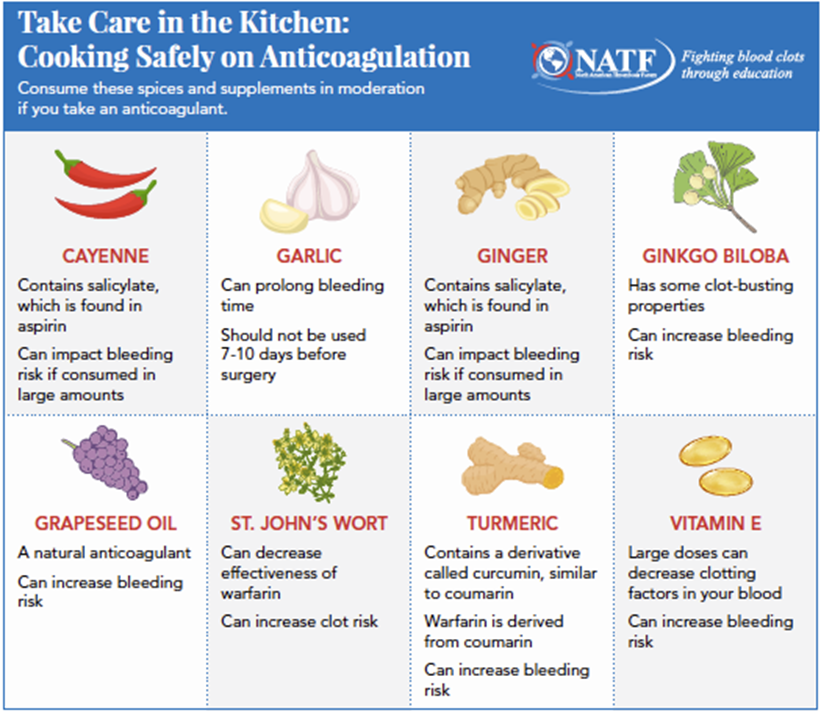The patient is to be started on warfarin (Coumadin) therapy. It is important for the nurse to check for the use of which herbs? (Select All that Apply)
Valerian
Ginkgo biloba
Echinacea
Ginger
Garlic
Correct Answer : B,C,D,E
A. Valerian:
Valerian is an herb commonly used for its sedative and anxiolytic properties. There is limited evidence suggesting potential interactions between valerian and warfarin, but it is not considered a major concern for altering warfarin's anticoagulant effects. However, caution is still warranted, and healthcare providers should monitor patients for any signs of increased bleeding if they are using valerian along with warfarin.
B. Ginkgo biloba:
Ginkgo biloba is an herb often used for its cognitive-enhancing properties and to improve circulation. There is some evidence to suggest that ginkgo biloba may interact with warfarin and increase the risk of bleeding due to its anticoagulant effects. Therefore, patients taking warfarin should use ginkgo biloba cautiously and inform their healthcare providers if they are using it.
C. Echinacea:
Echinacea is an herb commonly used to boost the immune system and treat colds and respiratory infections. Some studies suggest that echinacea may interact with warfarin and potentially increase the risk of bleeding. Therefore, it's essential for patients taking warfarin to avoid or use echinacea cautiously and to inform their healthcare providers if they are using it.
D. Ginger:
Ginger is an herb commonly used for its anti-inflammatory and digestive properties. Some studies suggest that ginger may interact with warfarin and increase the risk of bleeding due to its anticoagulant effects. Patients taking warfarin should use ginger cautiously and inform their healthcare providers if they are using it.
E. Garlic:
Garlic is an herb known for its cardiovascular benefits and potential anticoagulant effects. Some studies suggest that garlic may interact with warfarin and increase the risk of bleeding. Patients taking warfarin should use garlic cautiously and inform their healthcare providers if they are using it.

Nursing Test Bank
Naxlex Comprehensive Predictor Exams
Related Questions
Correct Answer is D
Explanation
A.Alcohol:
Alcohol consumption does not directly reduce the absorption of ciprofloxacin. However, alcohol can interact with certain medications and may exacerbate side effects such as dizziness, drowsiness, and gastrointestinal upset. It’s generally advisable to avoid excessive alcohol consumption while taking ciprofloxacin, but alcohol itself does not significantly affect the absorption of the medication.
B. Intense physical exertion:
Intense physical exertion is unlikely to directly reduce the absorption of ciprofloxacin. However, gastrointestinal motility may increase during intense exercise, potentially affecting the absorption of oral medications. In some cases, gastrointestinal disturbances associated with physical exertion may affect the absorption of ciprofloxacin, but this effect is generally minor and not a significant concern for most individuals.
C. Fruit juices, in particular grapefruit juice:
Grapefruit juice is known to interact with certain medications by inhibiting intestinal enzymes responsible for drug metabolism, leading to increased drug concentrations in the bloodstream. However, ciprofloxacin is not significantly affected by grapefruit juice. In fact, fruit juices, including grapefruit juice, are generally not known to reduce the absorption of ciprofloxacin.
D. Antacids or mineral supplements:
Antacids and mineral supplements containing aluminum, magnesium, calcium, or iron can significantly reduce the absorption of ciprofloxacin when taken concurrently. These substances can form complexes with ciprofloxacin in the gastrointestinal tract, reducing its bioavailability. Therefore, it’s recommended to avoid taking antacids or mineral supplements containing these minerals within a few hours before or after taking ciprofloxacin to avoid interference with its absorption.
Correct Answer is ["50"]
Explanation
To calculate the infusion rate in gtt/min, the nurse needs to use the formula:
Infusion rate (gtt/min) = Volume (mL) x Drop factor (gtt/mL) / Time (min)
Plugging in the given values, we get:
Infusion rate (gtt/min) = 400 mL x 60 gtt/mL / 480 min
Simplifying, we get:
Infusion rate (gtt/min) = 50 gtt/min
Therefore, the nurse should set the manual IV infusion to deliver 50 gtt/min.
Whether you are a student looking to ace your exams or a practicing nurse seeking to enhance your expertise , our nursing education contents will empower you with the confidence and competence to make a difference in the lives of patients and become a respected leader in the healthcare field.
Visit Naxlex, invest in your future and unlock endless possibilities with our unparalleled nursing education contents today
Report Wrong Answer on the Current Question
Do you disagree with the answer? If yes, what is your expected answer? Explain.
Kindly be descriptive with the issue you are facing.
